The Myth of Socialist Zionism – Tony Greenstein talk today 6 pm
Like Jacob and Esau, Zionism and Socialism have always been irreconcilable foes

Why Zionism and Socialism are Incompatible
Talk No. 3 – Labour Left Alliance 9th April 6 pm
Register here
This Friday I shall be giving the third of five talks. The theme will be Zionism and Socialism. When I grew up it was a common myth that Israel was a socialist society. In Israel, Histadrut, the Zionist ‘trade union’ was the biggest employer after the state itself. Where else in the world would you have the commanding heights of the economy in the hands of the unions? To many social democrats, who lacked any class analysis, Israel was a dream come true.
I can remember the family solicitor, Rex Makin, who had defended me on a charge of possession of dope, telling me in his plush offices that if I was a socialist then I should go to Israel and join a kibbutz. Rex himself ended up defending British Movement members!

A May Day Demonstration by Mapam – complete with Zionist and Red Flags – However the Arabs formed no part of their socialism
The belief that Zionism has a left and a right-wing is a common one. Even some Trotskyists, such as 4th International supporter Gilbert Achcar, criticised the equation of Zionism and racism for its
‘totalizing nature … we can hardly treat all Zionists … as birds of the same racist feather. There is Zionism and there is ‘Zionism’’ [i]
It is a common myth that Zionism has a left and a right. In fact all Zionist groups, without exception, subscribe to the idea of a Jewish Supremacist State. The differences between left and right have always been tactical not principled.
It was the ‘left’ Zionists who built the state and created the apartheid architecture such as the JNF which remains to this day. It is the ‘right-wing’ Zionists who have taken what Labour Zionism built whilst jettisoning state capitalism in favour of neo-liberalism.
Labour Zionism was instrumental in the creation of the Israeli state but today it has no role to play. We are witnessing its death agony. In 1949 the 2 Labour Zionist parties won 65 out of 120 seats in Israel’s first elections. In the March 2021 elections they won just 13, a sharp decline from 2015 when they won 29 seats though an improvement on the March 2020 elections when they won just 7.

Insignia of the left-Zionist youth group Hashomer Hatzair
It took a lot of unlearning before I came to terms with the fact that Israel was as far as it was possible to be from the ideas of socialism. Even as a teenager moving towards Marxism, I remember feeling that socialism and Zionism were incompatible
Why? Because Zionism, even of the ‘socialist’ variety, stressed Jewish unity regardless of class. Zionism was an exclusivist project that had no place for non-Jews, still less Arabs.
The Kibbutz – A socialist experiment?
The myth that Zionism had originated in socialism was based on the collective settlements in Palestine, which were the result of ‘an alliance between the embryonic labour movement and the Zionist financial institutions’. The pragmatism of the pioneers was revealed in their readiness to enter into an alliance with the Jewish bourgeoisie abroad.’[ii]
The Kibbutz ‘emerged directly from the interaction between Ruppin and the young immigrants of the Second Aliyah.’ [iii] Collective forms of colonisation were the most efficient and effective means of colonising Palestine. They were not a means of changing society but ‘tools in forging national sovereignty.’ [iv] Their internal social structure was designed to reflect this, eliminating personal space in favour of a collective identity. They were a Zionist Sparta, intended to produce warriors without attachments of affection to each other or even to their children. ‘Everything was the property of the collective including the individual’s thoughts.’ [v]
Owen Jones, in his recent book This Land, spoke of Israel’s ‘original socialist principles’. The kibbutzim were ‘the incubators of a new socialist society.’
Today no one (except racists like Jones) has any illusions that the kibbutzim are socialist. They have always refused to admit Arabs as members. Today they are exploiters of Arab and Oriental Jewish labour. They are collective capitalists. Established on the ruins of the Palestinian villages the Kibbutzim took a major role in the ethnic cleansing of the Palestinians.
The late Gerald Kaufmann MP compared the influence of the Kibbutz to that of Eton in the Tory Party.[vi] Between 1949 and 1969, one third of Israeli cabinet ministers came from the Kibbutzim.[vii] They also supplied a disproportionate number of senior Israeli officers.
But you may ask: wasn’t it true that when it was founded Zionism was a socialist project? Here we come up against another aspect of Zionism. Its ability to successfully rewrite history. So what is the truth? Was Zionism another failed attempt at achieving a socialist society or was it always a settler colonial movement?
This is what my talk is going to be about and I am going to explain that Zionism, from the very beginning, was a reactionary, racist and indeed anti-Semitic, movement.
The Pogroms
Zionism arrived late on the scene at the end of the 19th century during the late colonial era. Its arrival coincided with an increase in pogroms against Jews in the Pale of Settlement in Czarist Russia where the vast majority of world Jewry lived.
The reaction of the Jews to these pogroms, which claimed thousands of lives, the most notorious being at Odessa in 1871 and 1881 and Kishinev in April 1903 was the emergence of Jewish self-defence. The Kishinev pogrom was perpetrated by the Black Hundreds which were financed by the Czarist regime and organised by Minister of the Interior, Count von Phleve.
Anti-Semitism led to Jews joining the socialist and revolutionary movements. It is estimated that Jews accounted for some 25-30% of revolutionary activists in Russia between 1886-1889. In the principal area of revolutionary activity, the provinces in the South, some 35-40% of activists were Jewish. This is the context in which socialist Zionism emerged.
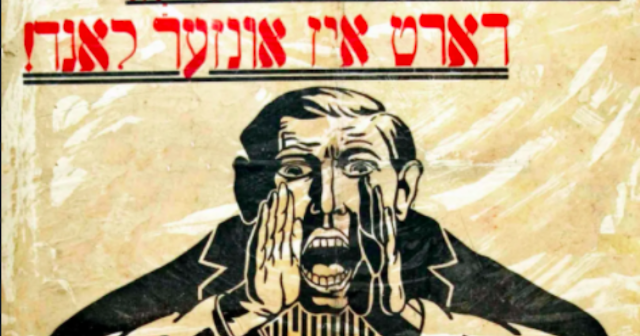
Poster of the Jewish Socialist Bund
The first Jewish socialist movement was the Bund, the General Jewish Workers Union of Russia, Poland and Lithunia. It was officially formed in 1897 in Vilna but early Jewish workers groups had been formed around the beginning of the 1890s.
The Bund was hostile to Zionism and claimed that the fledgling socialist Zionist groups,[viii] wore a red mask to hide their real intentions and to conform to the radical zeitgeist.[ix] Socialist Zionism arose as a result of the conflict between Zionism’s support for the existing order and the Jewish proletariats’ class interests.[x]The Bund regarded Zionism as a nationalist diversion from the class struggle[xi] and ‘the most evil enemy of the organised Jewish proletariat’.[xii]
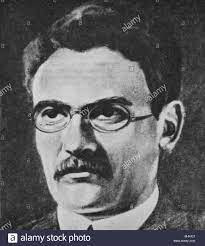
Borochov and Labour Zionism
The first socialist Zionist groups emerged around Ber Borochov, a so-called Marxist Zionist. Poalei Zion, [PZ] was formally founded in 1906 in Poltava, Ukraine.
Borochov held that because most Jews were not proletarianised they could not take part in the class struggle. This was at a time when Jewish workers were making a major contribution to the revolutionary struggle in Russia.
‘The class struggle can take place only where the worker toils,… As long as the worker does not occupy a definite position, he can wage no struggle.’[xiii]
Borochov argued that the class structure of Jews was like an inverted pyramid. There were too many rich Jews and too few Jewish workers. Only in Palestine could a Jewish society emerge with a normal socio-economic structure. Borochov was simply ignorant of the changing class nature of the Jewish workers.
Borochov argued that because Jewish workers had no territory from which to wage class struggle, they first had to change their conditions of production. The answer was not emigration to another country like Britain. That would only replicate the problem: ‘Jewish migration must be transformed from immigration into colonization.’[xiv] There was no reason why Jews should emigrate to Palestine other than religious obscurantism. Borochov sought to solve the problems of the Jewish workers through the colonisation of Palestine.[xv]
Borochov argued that not only a Jewish proletariat but a Jewish bourgeoisie needed to be created. The Jewish class struggle in Russia was “essentially hopeless” and had to be postponed until there was a Jewish bourgeoisie.[xvi] This was the fatal weakness of labour Zionism. It had to create a Jewish bourgeoisie in order to wage a struggle against it!
Once in Palestine the Jewish proletariat would, having displaced the Arabs, unite with them in class struggle against that same Jewish bourgeoisie. We can see the results of that today.
The Zionist movement and the Czarist regimes
The Zionist movement was formed in 1897 at the 1st Zionist Congress in Basel, Switzerland. The Congress had originally intended to meet in Munich but the Jews of Munich rose as one and accused the authorities of anti-Semitism for allowing the Congress to meet.
It may seem strange today when Zionists speak of nothing else but anti-Semitism that a century ago Zionism was seen by the vast majority of Jews as a form of Jewish anti-Semitism. Zionism did establish a base among the Jews, but it was in Eastern Europe. The major reason that the Jewish bourgeoisie in Britain eventually adopted Zionism was in order to keep out the East European Jews.
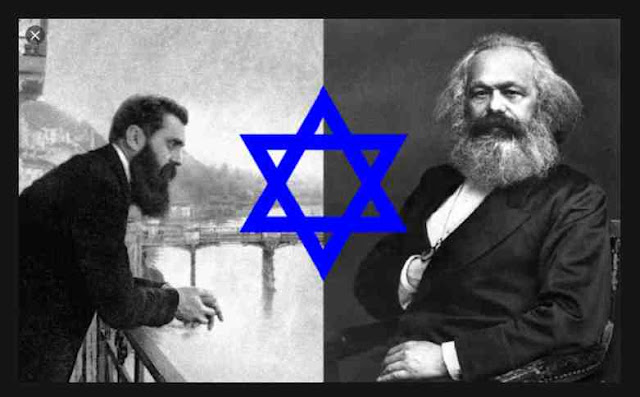
The President of the Zionist Organisation was Theodor Herzl, a Viennese journalist based in Paris. In his Diaries he wrote that
In Paris… I achieved a freer attitude towards anti-Semitism, which I now began to understand historically and to pardon. Above all, I recognise the emptiness and futility of trying to ‘combat’ anti-Semitism.
In the middle of the Dreyfuss Affair Herzl was willing to ‘understand and to pardon’ anti-Semitism. This should give people an idea of Zionism’s real commitment to fighting anti-Semitism.
Herzl spent his time wandering about Europe meeting different leaders – from the German Kaiser to the Italian King Victor Emmanuel, from the Pope to the Ottoman Sultan. His aim was to persuade them to back his project for a Jewish state in Palestine.
When Herzl met the Grand Duke of Baden, the Kaiser’s uncle
‘took my project for building a state with the utmost earnestness. His chief misgiving was that if he supported the cause, people might accuse him of anti-Semitism’.[xvii]
As Francis Nicosia observed:
‘whereas today non-Jewish criticism of Zionism or the State of Israel are often dismissed as motivated by a deeper anti-Semitism, in Herzl’s day an opposite non-Jewish reaction, one of support for the Zionist idea, might have resulted in a similar reaction.’[xviii]
What then had Herzl to offer these reactionary regimes? Herzl warned the leaders of Europe that if the Zionist project were to fail, ‘hundreds of thousands of our adherents would at one swoop change over to the revolutionary parties.’[xix]
Barely 4 months after the Kishinev pogrom, Herzl travelled to Russia to meet with the author of the Kishinev pogrom Count von Plehve and the Czarist Finance Minister Count Witte. The latter openly desired to annihilate Russia’s Jews. Witte complained that half of the membership of the revolutionary parties was Jewish.[xx]
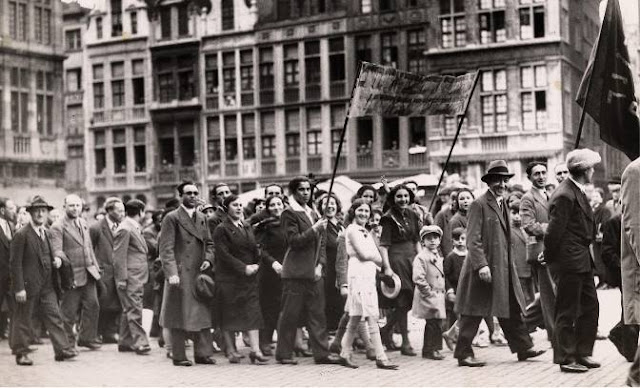
Bundist rally in Brussels in 1935
Why did Herzl meet these Czarist Ministers? Because he wished the Zionist movement in Russia, alone of political movements, to maintain its legal status. From 4-10 September 1902 the first all-Russian Zionist Congress had been held in Minsk, with the Czarist government’s permission.[xxi] Relations had then cooled which was why Herzl had come to Russia.
What Herzl offered was an alternative to the attractions of the revolutionary movements to Jewish workers. Herzl asked Plehve ‘Help me to reach land sooner and the revolt will end. And so will the defection to the Socialists.’[xxii]Herzl promised that the revolutionaries would stop their struggle in return for a Charter for Palestine in 15 years. The Bund were outraged.[xxiii]
In a letter to Baroness Suttner, Herzl described Zionism’s role:
‘we are everywhere engaged in battles with the revolutionaries and are actually turning the young students as well as the Jewish workingmen away from socialism and nihilism by unfolding before them a pure and national ideal.[xxiv]
Herzl wrote to the Kaiser describing how:
‘Our movement… has everywhere to fight an embittered battle with the revolutionary parties which rightly sense an adversary in it. We are in need of encouragement even though it has to be a carefully kept secret.’[xxv]

von Plehve to Herz – Extract from p. 1525 Herzl’s Diaries
When Herzl began explaining to Plehve why he should support the Zionist movement, Plehve replied
You don’t have to justify the movement to me. Vous prechez a un converti (You are preaching to a convert). But ever since the Minsk conference we have noticed un changement des gros bonnets [a change of bigwigs]. There is less talk now of Palestinian Zionism than there is about culture, organization and Jewish nationalism. This doesn’t suit us….Ussishkin is the only man in Russia who is with you. (I was secretly amazed at this knowledge of personalities. It proved to me how much serious study he has given the question).’ [xxvi]

Bundist Demonstration
Plehve agreed to both the legalization of the Zionist movement and the publication of a Zionist daily Der Fraind. In return Herzl promised that he would play down the Kishinev pogrom at the 6th Zionist Congress which was due to start two weeks later. Herzl explained that Plehve
‘was much concerned about the Congress, evidently because of the inevitable re-opening of the Kishinev matter there. I could do him a service by couper court [cutting short] the discussion.’ [xxvii]
The 1903 Zionist Congress, which took place 5 months after Kishinev, remained silent about the pogroms just as 30 years later in Prague, it would remain silent about the Hitler regime.
Kishinev also created a crisis for the fledgling Labour Zionist groups, who realised that they could not ignore the struggle against anti-Semitism.[xxviii]
The ‘Marxist’ Zionists of Poalei Zion, the ‘Workers of Zion’, were followers of Ber Borochov, who was expelled from the Russian Social Democratic Party in May 1901, for supporting Zionism.[xxix] Although PZ groups formed in various locations, beginning in Minsk in 1897, PZ was formally founded in 1906 in Poltava, Ukraine.[xxx]
In parts of the Diaspora, especially Poland and Russia, as the class struggle intensified, Labour Zionist parties were drawn into the fight against anti-Semitism. In Poland PZ split into a Right and Left Poalei Zion. [LPZ] At its February/March 1919 Conference. LPZ emerged as much the stronger.[xxxi]
LPZ moved steadily towards abandoning Zionism. The dream of Palestine proved just that. It had no relevance to the day to day struggle against the Endeks and the Nationalists. Only the Bund was able to provide self-defence against the middle-class rabble and anti-Semitic gangs.
In Russia the success of the revolutionaries in overthrowing the Czarist regime in February 1917 lessened the attraction of Zionism. At a stroke all anti-Semitic legislation was abolished by the Petrograd Soviet. As a front-page headline in the main party newspaper Pravda put it in 1918: “To be against the Jews is to be for the Tsar!” On 22 June the First Congress of Soviets passed unanimously a resolution on ‘The Struggle Against Antisemitism’. At their conference in Petrograd in June 1917 the Russian Zionists omitted all mention of British sponsorship of the Zionist settlement in Palestine. Zionism lost its attraction as the fight against anti-Semitism succeeded.[xxxii]
Zionism had obtained after the first World War a mass base in Poland. The 3 million Jews there were the oppressed of the oppressed. In Abram Leon’s words the Jews found themselves ‘wedged between the anvil of decaying feudalism and the hammer of rotting capitalism.’[xxxiii]
Zionism was a form of political messianism and in times of despair Jews looked to the intervention of god and their ‘restoration’ to a place where they were safe. However the Bund, an anti-Zionist Jewish party, preferred to rely on themselves rather than god and they organised Jewish self-defence, often in co-ordination with the Polish Socialist Party. By 1938 the Bund had conquered the Jewish community. In the last free elections in Poland the Bund gained in Warsaw no less than 17 of the 20 Jewish Council seats. By contrast the Zionists gained just one seat. [xxxiv] Isaac Deutscher, the biographer of Trotsky, explained that:
‘to the Jewish workers anti-Semitism seemed to triumph in Zionism, which recognised the legitimacy and the validity of the old cry ‘Jews get out!’ The Zionists were agreeing to get out.’[xxxv]
Palestinian PZ was always to the right of its diaspora sections because the latter were drawn into the class struggle whereas the former was motivated by the needs of settler colonialism into allying with the British colonial authorities.
The Labour Zionist settlements were established with the money of the Jewish bourgeoisie. The first thing they did was to exclude the Palestinian peasants from the land and they organised a militia, Hashomer, (the Guard) the forerunner of Haganah, to enforce this.
There were two Zionist Labour Parties – Ahdut Ha’avodah (formerly PZ) and Hapoel Hatzair, an avowedly non-socialist party. Between them they created Histadrut. Histadrut was a Jewish only trade union, except that it wasn’t a trade union. Golda Meir described Histadrut as a ‘big labor union that wasn’t just a trade union organisation. It was a great colonizing agency.’[xxxvi] Pinhas Lavon, its Secretary-General, described it as ‘a general organisation to its core. It is not a trade union …’[xxxvii] The Histadrut was a ‘state in preparation.’ [xxxviii]
In 1930, after Hapoel Hatzair had been convinced that Ahdut Ha’avodah was as opposed to socialism as they were, they agreed to merge and form Mapai, the Israeli Labor Party.[xxxix]
Histadrut was a thoroughly racist, anti-socialist organisation. When MOPSI, the embryonic Communist Party came out in 1924 as an anti-Zionist party, Histadrut collaborated with the British authorities in having their militants deported.
The major campaigns of Histadrut were Jewish Land, Labour and Produce. What this meant was that Jewish employers should not employ Arabs, that Jewish housewives should not buy Arab produce and that land once bought should be Arab-free. The Labour Zionists created an economy within an economy and a state within a state.
David HaCohen, of Solel Boneh, Histadrut’s building company, described the dilemmas of a “socialist” Zionist:
‘I had to fight my friends on the issue of Jewish socialism, to defend the fact that I would not accept Arabs in my Trade Union, the Histadrut; to defend preaching to housewives that they should not buy at Arab stores; to defend the fact that we stood guard at orchards to prevent Arab workers from getting jobs there… to pour kerosene on Arab tomatoes; to attack Jewish housewives in the markets and smash Arab eggs they had bought; to praise to the skies the Kereen Kayemet [Jewish Fund] that sent Hankin to Beirut to buy land from absentee effendi [landlords] and to throw the fellahin [Arab peasants] off the land; to buy dozens of dunums from an Arab is permitted but to sell God forbid one Jewish dunum to an Arab is prohibited; to take Rothschild the incarnation of capitalismas a socialist and to name him the ‘benefactor’ – to do all that was not easy.’[xl]
Ze’ev Sternhell described Labour Zionism as ‘nationalist socialism’. He would have used the term ‘national socialism’ but it ‘has been contaminated by association with the Nazis.’ [xli]
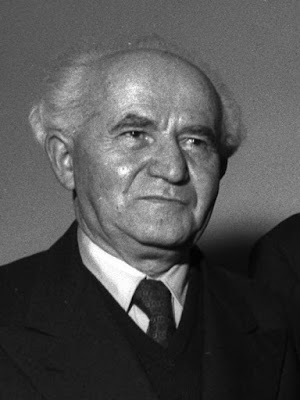
David Ben Gurion – Ethnic cleanser & 1st Israeli Prime Minister
Class Struggle or Nationalist Struggle?
Speaking of ‘the evil of mixed labour’ David Ben-Gurion, the first Israeli Prime Minister, described the employment of Arabs as ‘class–hatred of intelligent Jewish labour.’[xlii]
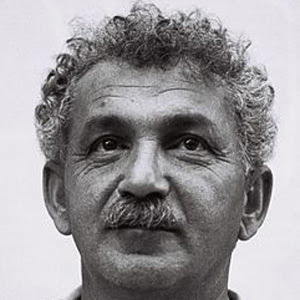
Berl Katznelson – Ben Gurion’s effective deputy
To Berl Katznelson equality ‘was only a whip with which to scourge the concept of Jewish labor.’ [xliii] Sternhell wrote of Katznelson that
‘What shook this spiritual shepherd to the depths of his soul was not the civil war in Spain or the rise of Nazism but an exchange of populations between two kibbutzim…’ [xliv]
Ben-Gurion coined the slogan ‘From class to nation’ and redefined the class struggle as a war against Arab workers. [xlv] Labour Zionism consciously undermined Palestinian trade unionism.
Jewish class struggle in Palestine, was for the most part a fight against Arab workers. To be anti-capitalist in Palestine almost always meant to be practically anti-Arab.’ [xlvi]
The Union of Railway, Postal and Telegraph Workers was a bastion of the left with a mixed Arab-Jewish membership. Histadrut incorporated the union in order to separate Arab from Jewish workers and it created a separate Arab section.[xlvii] Arab workers objected to Histadrut’s Zionism and its policy of Jewish Labour. They therefore had no place in Histadrut.
When Histadrut was Israel’s second largest employer, it refused to employ Arabs in virtually all its factories (arms, oil, electronics etc.) on ‘security grounds’.[xlviii] Only its building company, Solel Boneh, which helped build the settlements, employed Arabs. This was tantamount to a colour bar.[xlix] Military service was a condition of most employment[l] and Israel’s Arabs didn’t serve.[li] Histadrut deliberately refused to invest in industry in Arab villages and towns.
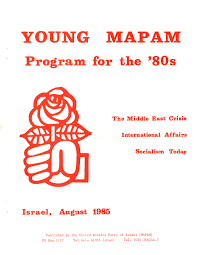
Mapam, the United Workers Party, described itself as Marxist but in practice it was no different from Mapai, the Israeli Labour Party. “Their socialism did not extend to their non-Jewish fellow men.” [lii]

The forced expulsion of Palestinian refugees in 1947-48 – The Nakba
Thousands of Palestinians were massacred in 1947-8 in order to encourage their flight.[liii] In November 1948, Eliezer Peri, the editor of Mapam’s newspaper Al Hamishmar, received a letter describing a massacre at al-Dawayima. Benny Morris estimated that there were hundreds of dead.[liv] Agriculture Minister Aharon Cisling referred to a letter he had received from Eliezer Kaplan, declaring: ‘I couldn’t sleep all night … Jews too have committed Nazi acts.’ [lv] Cisling agreed that publicIy Israel must admit nothing; but the matter must be thoroughly investigated. ‘The children they killed by breaking their heads with sticks. There was not a house without dead’.[lvi]
Mapam’s Political Committee was briefed on 11 November 1948 by the recently ousted Chief of Staff of the Haganah, Yisrael Galili, about the killing of civilians during Operations Yoav and Hiram. Aharon Cohen led a call for an independent inquiry.[lvii] The problem was that the commanders of these operations were senior Mapam members, Yitzhak Sadeh and Moshe Carmel.
The Jewish Working Class
Zionism was irrelevant to Jewish workers. In 1886 the socialist Arbayter Fraynd published ‘a series of biting attacks on the “Golden Calf” of Zionism. Zionism and socialism were ‘mutually antagonistic.’[lviii] Alec, a fictional character in Simon Blumenfeld’s novel Jew Boy remarked, ‘I don’t see why I should change one set of exploiters for another because they are Jewish.’ [lix]
The Communists were seen as people who matched words with deeds. Even East End Jewish businessmen gave money to the Communist Party to help combat the Fascist menace.[lx] David Cesarani wrote that during the 1930’s ‘Zionism was in a state of collapse in the East End.’ A correspondent to the Young Zionist in December 1932 wrote that ‘The tendency in the best part of our Jewish working class… is to join the Communist Party.’ and that Zionism ‘has made no headway’ amongst young working class Jews.’ [lxi]
Joe Jacobs, an activist in the Communist Party wrote that ‘The Jews in East London were not yet in favour of Zionism… Many Jews rejected Zionism entirely.’ Their opposition to Zionism was made easier because they had originated from Eastern Europe where the Bund had fought a bitter fight against Zionist class collaboration.[lxii] To Mick Mendel, a prominent communist leader and trade unionist ‘Zionism was not a solution – not even an inferior one – but an escape.’ [lxiii]
Up till 1945 the majority of British Jews were working-class. Most Jews lived in the tenements of the East End. Hostility to Zionism was strongest among Jewish workers. As Jewish tailor, I Stone said, at the great meeting of the Hebrew Socialist Union of August 26 1876
‘The unity of Israel has become a great lie since the underlying class struggle exists also amongst Jews… Therefore Jewish workers must unite among themselves against the other spurious unity – that with the masters!’[lxiv]
For the first 30 years, from 1948-1977 it was the Israeli Labour Party which formed every ruling coalition in Israel. Mapai was primarily a party of the state. It created Israeli Apartheid through the expulsion of ¾ million Palestinians and through incorporating the Jewish National Fund into managing Israel’s land. The JNF’s constitution only allowed it to serve the Jewish population so by passing the 1953 JNF Law, the ILP was deliberately introducing land apartheid. All the rest of the discrimination between Jews and Arabs followed from this.
In 1977, in the wake of the Yom Kippur war and with the support of the Oriental/Misrahi Jews who Mapai had discriminated against, Likud under Menachem Begin came to power. Since then the ILP has only formed a government twice. Today as the Israeli Jewish electorate vote for far-Right or even further Right parties, the Zionist left is simply irrelevant.
But Labour Zionism was never a socialist wing of Zionism. It is no accident that when Jeremy Corbyn became leader of the Labour Party that the Jewish Labour Movement led the ‘anti-Semitism’ attacks on him. Today the only role of labour Zionism is as the operative arm of the Labour Right.
[i] Gilbert Achcar, 274, The Arabs and the holocaust,London: Saqi Books, 2010.
[ii] Noah Lucas, The Modern History of Israel, p.56.
[iii] Etan Bloom, What ‘The Father had in mind’ p. 177.
[iv] Ze’ev Sternhell, Founding Myths, p. 325.
[v] Etan Bloom, What ‘The Father had in mind’ p. 346.
[vi] To Build the Promised Land 1973.
[vii] Israeli Founders & Sons, Amos Elon.
[viii] Levin, p. 392. Borochov organised one of the first in Ekaterinoslav in 1900.
[ix] Lacquer, History of Zionism, p.273
[x] Noah Lucas, p.35, Modern History of Israel, Weidenfield & Nicholson, 1975.
[xi] Henry Tobias, p.172,
[xii] Henry Tobias, p.251, Reportto the 2nd International in 1904.
[xiii] Ber Borochov, The National Question and the Class Struggle, ‘The Zionist Idea’ Arthur Hertzberg, p .358. See David Green, This day in Jewish history / A great Zionist mind dies young, Ha’aretz 17.12.12. https://tinyurl.com/y6bdg7qp
[xiv] Ber Borochov, Our Platform, Hertzberg p .364.
[xv] Borochov, in a polemic with the Territorialists, speaks of ‘the national advantage of the Land of Israel, as an object of special endearment’. The Question of Zion and Territory, https://tinyurl.com/y4bt4twr
[xvi] N. Levin, p. 266.
[xvii] Lowenthall, Diaries of Theodor Herzl, p.118.
[xviii] Nicosia, ZANG, p.7.
[xix] Herzl Complete Diaries p.799.
[xx] Witte related that he told the late Czar Alexander III that ‘if it is possible to drown the 6 or 7 million Jews in the Black Sea, I have absolutely no objection to it.’ Diaries, p.1530.
[xxi] Minsk Conference, Encyclopedia.com, https://tinyurl.com/2ea5znbb
[xxii] Herzl, Complete Diaries, p. 1526
[xxiii] Henry Tobias, p.252.
[xxiv] 16.1.1899., Diaries of Theodor Herzl, p.773.
[xxv] Herzl, Complete Diaries, p. 596.
[xxvi] Diaries of Thedor Herzl, Ed. Ralph Patai, p. 1525.
[xxvii] [Diaries, p. 1524]
[xxviii] Tobias, p.250.
[xxix] The Revolutionary Roots of Modern Yiddish, 1903-1917, Barry Trachtenberg, Syracuse UP, 2008, p.11.
[xxx] Zionism and Israel – Encyclopedic Dictionary Poalei Tziyon (Poale Zion) https://tinyurl.com/y3wl2efy
[xxxi] LPZ supported the Bolshevik revolution and participated in it. It was a Yiddish party. Samuel D. Kassow, Who Will Write Our History? Emanuel Ringelblum, the Warsaw Ghetto, and the Oyneg Shabes Archive, p.28, Indiana University Press, 2007 wrote: ‘Being a socialist Zionist party it was torn between the struggle in the here and now and in Palestine. The Party rejected the suggestion that the Yishuv was ‘better’ than the Diaspora or that the Labour movement in Palestine had any right to dictate to the Jewish workers in Poland.’ Its most famous member was Emmanuel Ringleblum, who compiled and hid the Oneg Shabbat files in Warsaw which described conditions for Jews in the ghetto. The Party steadily lost support in the inter-war period. It reached its peak in the late 1920s and declined thereafter as the Bund became stronger.
[xxxii] Leonard Stein, p. 437,
[xxxiii] A. Leon, p. 226.
[xxxiv] General Jewish Labour Bund in Poland, https://tinyurl.com/25te7yb3
[xxxv] Isaac Deutscher, ‘The Non Jewish Jew ‘ & Other Essays-The Russian Revolution and the Jewish Question’ pp.66/7.
[xxxvi] Electronic Intifada, 9.3.09. http://electronicintifada.net/content/histadrut-israels-racist-trade-union/8121 citing Uri Davies, Israel Utopia Incorporated, Zed Press, p.142.The Observer, 24.1.71.
[xxxvii] Moed, Histadrut Department of Culture and Education, 1963, p.3, quoted by Arie Bober (ed.), The Other Israel: The Radical Case Against Zionism, p.125.
[xxxviii] Ze’ev Sternhell, Founding Myths, p. 317.
[xxxix] Ze’ev Sternhell, p.78.
[xl] David Hirst, The Gun and the Olive Branch, p.185, Faber, 2003 citing Ha’aretz 15.11.69.
[xli] Sternhell pp. 6-7.
[xlii] David Ben-Gurion, Rebirth and Destiny, p.74.
[xliii] The Founding Myths of Israel, p.157. Ze’ev Sternhell, Princetown University Press, 1999.
[xliv] Ze’ev Sternhell Founding Myths, p. 267.
[xlv] Noah Lucas, p.48.
[xlvi] Hannah Arendt, The Jew as a Pariah, p. 203.
[xlvii] Gabriel Piterberg, The Returns of Zionism, Verso, 2008, pp. 72-73.
[xlviii] Emile Farjoun p.31-35 Khamsin 10,.
[xlix] Sawt el-Amel citing Sikkuy, “Sikkuy Report 2004-2005.”
[l] This is indirect discrimination, whereby an ostensibly neutral provision, practice or criteria impacts on a particular group disproportionately.
[li] Emmanuel Farjoun, “Class Divisions in Israeli Society,” Khamsin, no. 10, 1983, p.31-35.
[lii] Hirst, David, The Gun and the Olive Branch, p.25.
[liii] Ilan Pappe, The Ethnic Cleansing of Palestine, see Chapter 6 for The Massacre at Tantura (p.133) and Chapter 7 ‘The Escalation of the Cleansing Operations June-September 1948, pp. 146-179.
[liv] Survival of the Fittest, Ha’aretz 8.1.04. https://tinyurl.com/mzwu3xp see also Welcome To al-Dawayima, District of Hebron https://tinyurl.com/y5yda3ss
[lv] The Birth of the Palestine Refugee Problem Revisited, p.488., Benny Morris, 2004.
[lvi] Morris, p.470.
[lvii] Falsifying the Record: A Fresh Look at Zionist Documentation of 1948, Benny Morris Journal of Palestine Studies, Vol. 24, No. 3. (Spring, 1995), pp. 44-62.
[lviii] Stuart Cohen, English Zionists and British Jews, pp. 56-60.
[lix] Brian Klug, Anti-Zionism in London’s Jewish East End, 1890-1948, p.6.
[lx] Geoffrey Alderman, London Jewry and London Politics, 1889-1986, London: Routledge 1989, p.96.
[lxi] David Cesarani, ‘East End Jewry between the wars, Alderman, London Jewry pp. 96-97 cited by Klug, ‘Anti-Zionism in London’s Jewish East End’ p. 7.
[lxii] Joe Jacobs, Out of the Ghetto, pp. 208-209.
[lxiii] Brian Klug, Anti-Zionism in London’s Jewish East End, p. 8.
[lxiv] Fishman, p.115.